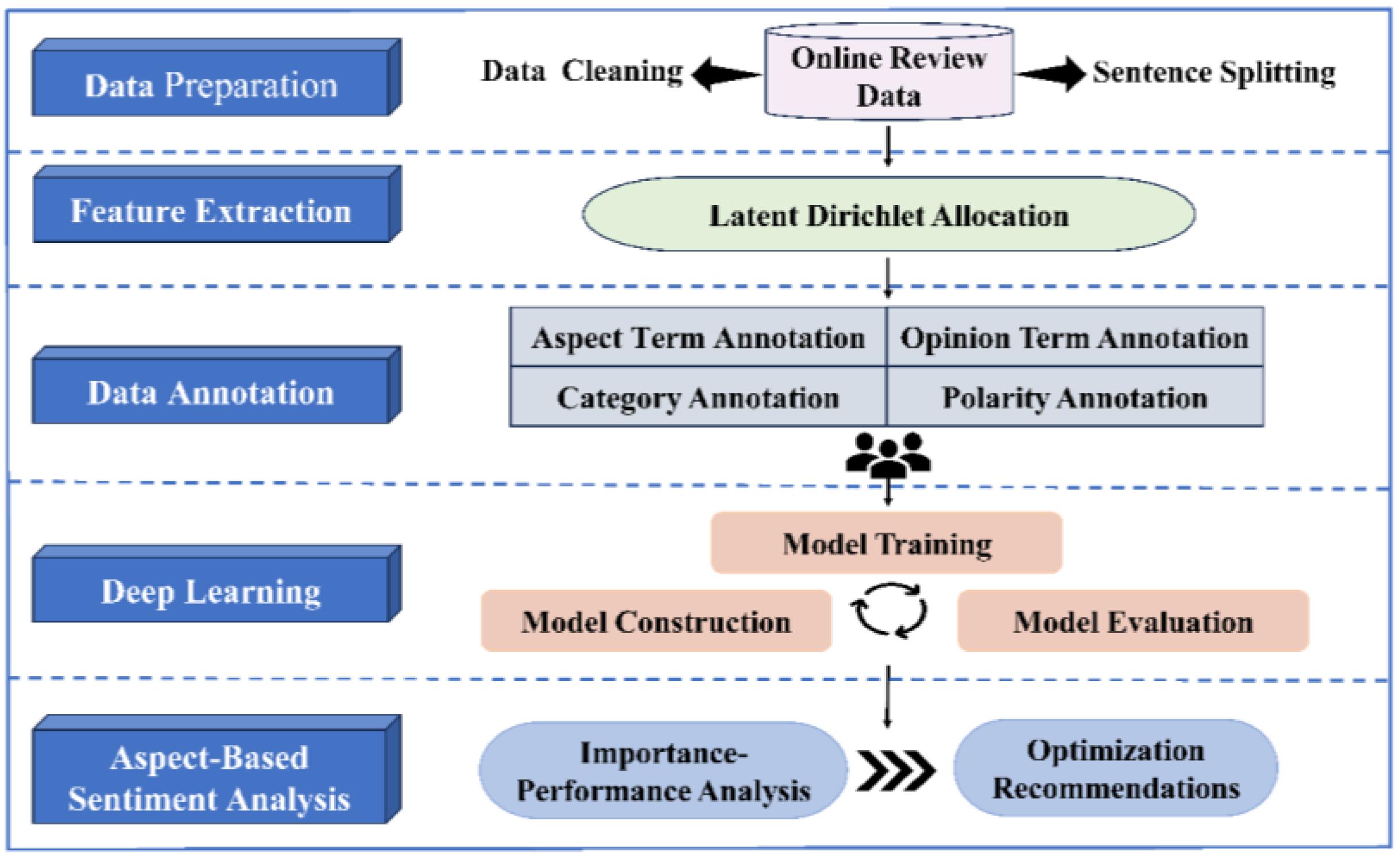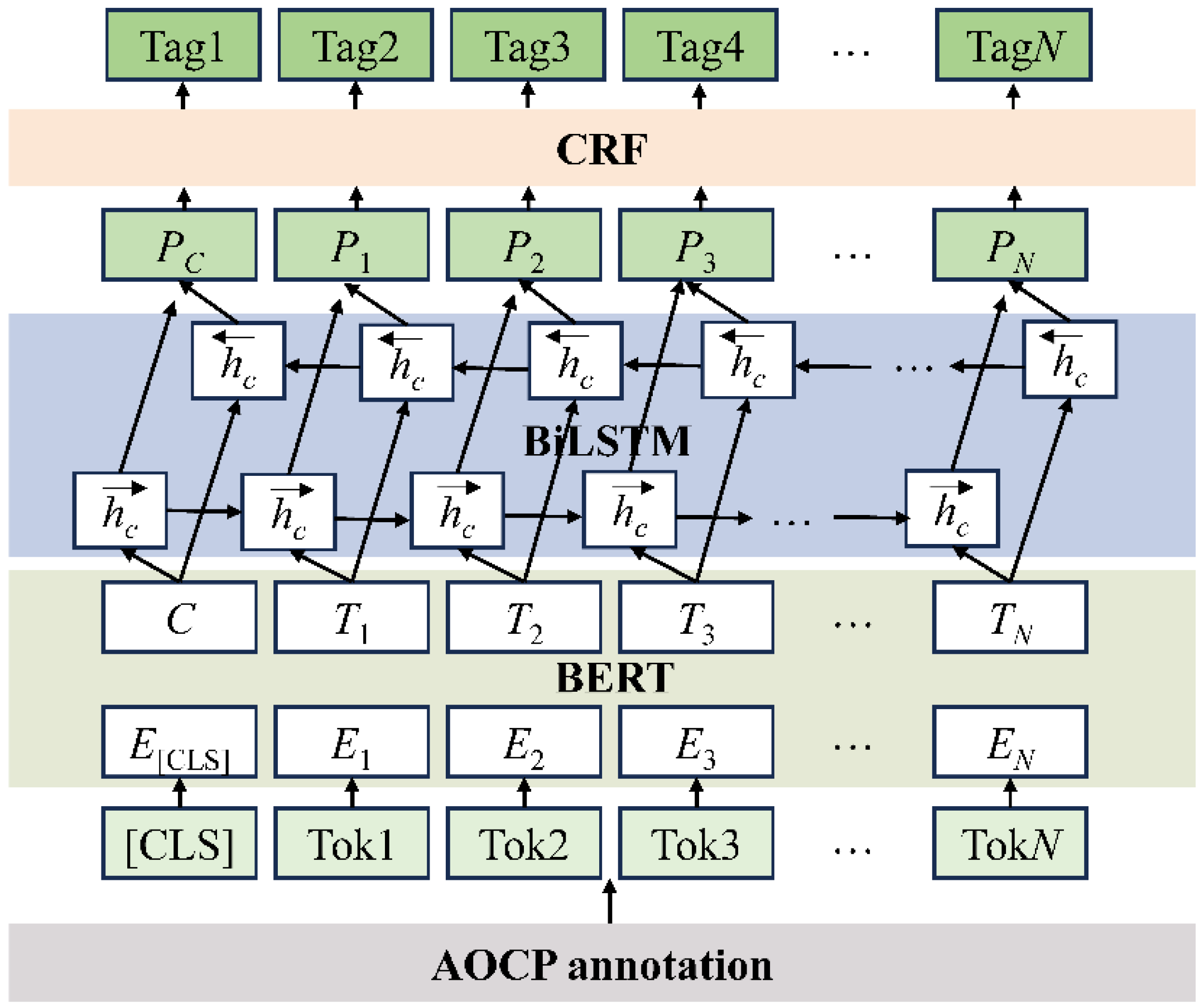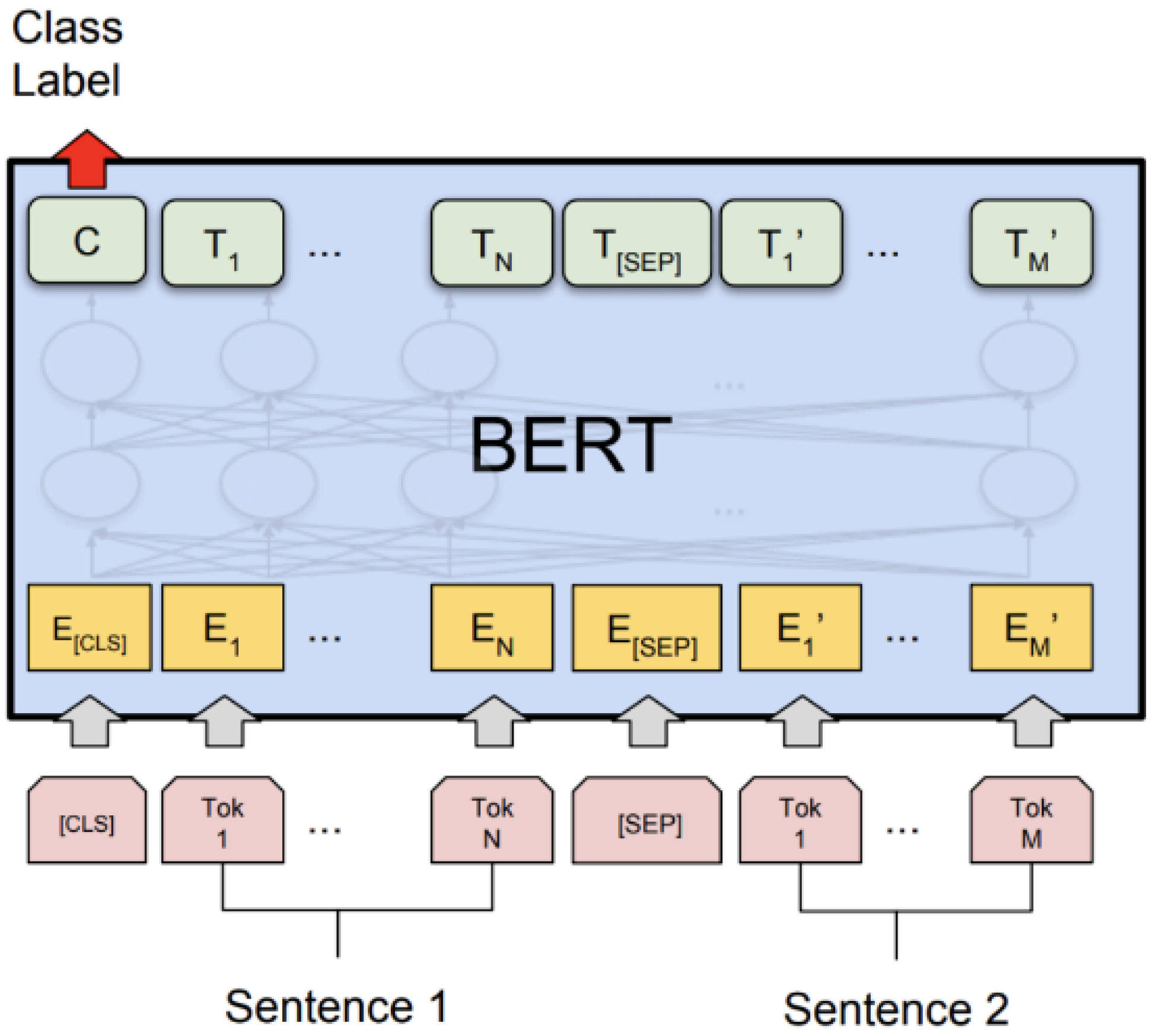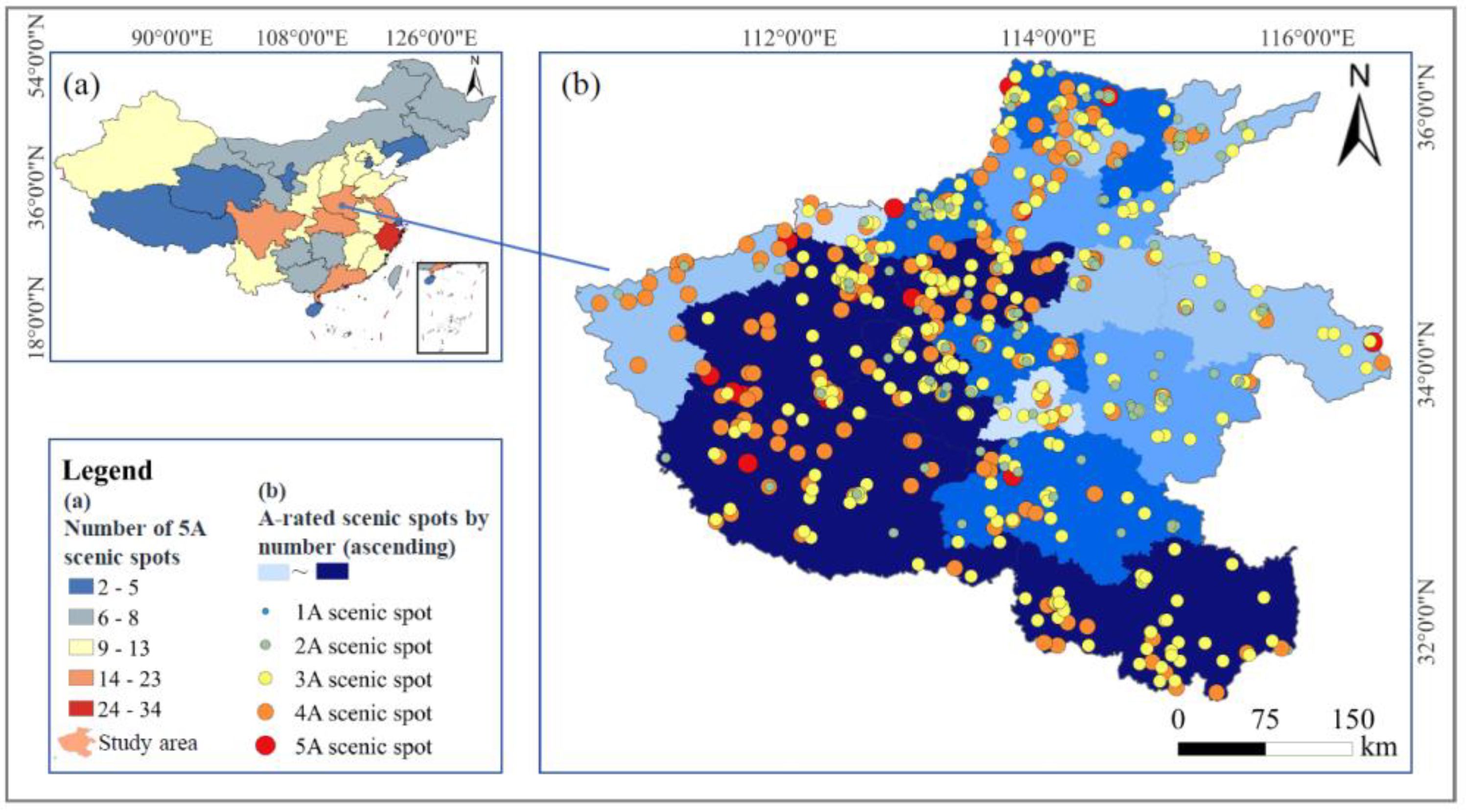A Deep Learning-Based Analysis of Customer Concerns and Satisfaction: Enhancing Sustainable Practices in Luxury Hotels
Abstract
1. Introduction
2. Literature Review
2.1. Satisfaction in Luxury Hotels
2.2. Sentiment Analysis of Online Reviews
2.3. Review of Aspect-Based Sentiment Analysis
3. Materials and Methods
3.1. Latent Dirichlet Allocation (LDA)
3.1.1. LDA Model
3.1.2. LDA Parameters
3.2. Deep Learning
3.2.1. AOCP Annotation
3.2.2. BERT Model
3.2.3. BiLSTM Model
3.2.4. CRF Model
3.2.5. Evaluation Metrics
3.3. Study Area and Data
4. Results
4.1. Topic Mining of Hotels Based on LDA Model
4.1.1. Determining the Number of Topics
4.1.2. Topic Mining
4.1.3. Data Annotation
4.2. Aspect-Based Sentiment Analysis of Hotels Based on Deep Learning
4.2.1. Model Training for Aspect-Based Sentiment Analysis of Hotels
4.2.2. Results for Aspect-Based Sentiment Analysis of Hotels
4.3. Aspect-Based Visualization
4.3.1. Overall Sentiment Visualization of Hotels
4.3.2. Fine-Grained Sentiment Visualization of Hotels
5. Discussion
5.1. Theoretical Implications
5.2. Practical Implications
5.3. Managerial Recommendations
5.4. Limitations and Future Research
6. Conclusions
Author Contributions
Funding
Institutional Review Board Statement
Data Availability Statement
Conflicts of Interest
References
- De Pelsmacker, P.; Van Tilburg, S.; Holthof, C. Digital marketing strategies, online reviews and hotel performance. Int. J. Hosp. Manag. 2018, 72, 47–55. [Google Scholar] [CrossRef]
- Chu, Q.H.; Zhang, Z.Q.; Wu, T.J.; Zhang, Z.L. Interaction between online retail platforms’ private label brand introduction and manufacturers’ channel selection. J. Retail. Consum. Serv. 2025, 84, 104208. [Google Scholar] [CrossRef]
- Berezina, K.; Bilgihan, A.; Cobanoglu, C.; Okumus, F. Understanding satisfied and dissatisfied hotel customers: Text mining of online hotel reviews. J. Hosp. Mark. Manag. 2016, 25, 1–24. [Google Scholar] [CrossRef]
- Zhang, D.; Niu, B. Leveraging online reviews for hotel demand forecasting: A deep learning approach. Inf. Process. Manag. 2024, 61, 103527. [Google Scholar] [CrossRef]
- Wu, T.J.; Zhang, R.X. Exploring the impacts of intention towards human-robot collaboration on frontline hotel employees’ positive behavior: An integrative model. Int. J. Hosp. Manag. 2024, 123, 103912. [Google Scholar] [CrossRef]
- Wang, P.; Hou, Y. The Effects of Hotel Employees’ Attitude Toward the Use of AI on Customer Orientation: The Role of Usage Attitudes and Proactive Personality. Behav. Sci. 2025, 15, 127. [Google Scholar] [CrossRef]
- Zhang, W.; Li, X.; Deng, Y.; Bing, L.; Lam, W. A survey on aspect-based sentiment analysis: Tasks, methods, and challenges. IEEE Trans. Knowl. Data Eng. 2022, 35, 11019–11038. [Google Scholar] [CrossRef]
- Hu, N.; Zhang, T.; Gao, B.; Bose, I. What do hotel customers complain about? Text analysis using structural topic model. Tour. Manag. 2019, 72, 417–426. [Google Scholar] [CrossRef]
- Wankhade, M.; Rao, A.C.S.; Kulkarni, C. A survey on sentiment analysis methods, applications, and challenges. Artif. Intell. Rev. 2022, 55, 5731–5780. [Google Scholar] [CrossRef]
- Tan, K.L.; Lee, C.P.; Lim, K.M. A survey of sentiment analysis: Approaches, datasets, and future research. Appl. Sci. 2023, 13, 4550. [Google Scholar] [CrossRef]
- Alqaryouti, O.; Siyam, N.; Monem, A.A.; Shaalan, K. Aspect-based sentiment analysis using smart government review data. Appl. Comput. Inform. 2020, 20, 142–161. [Google Scholar] [CrossRef]
- Do, H.H.; Prasad, P.W.; Maag, A.; Alsadoon, A. Deep learning for aspect-based sentiment analysis: A comparative review. Expert Syst. Appl. 2019, 118, 272–299. [Google Scholar] [CrossRef]
- Nazir, A.; Rao, Y.; Wu, L.; Sun, L. Issues and challenges of aspect-based sentiment analysis: A comprehensive survey. IEEE Trans. Affect. Comput. 2020, 13, 845–863. [Google Scholar] [CrossRef]
- Chen, Y.; Zhang, H.; Liu, R.; Ye, Z.; Lin, J. Experimental explorations on short text topic mining between LDA and NMF based Schemes. Knowl. Based Syst. 2019, 163, 1–13. [Google Scholar] [CrossRef]
- Buenano-Fernandez, D.; Gonzalez, M.; Gil, D.; Luján-Mora, S. Text mining of open-ended questions in self-assessment of university teachers: An LDA topic modeling approach. IEEE Access 2020, 8, 35318–35330. [Google Scholar] [CrossRef]
- Meng, F.; Yang, S.; Wang, J.; Xia, L.; Liu, H. Creating knowledge graph of electric power equipment faults based on BERT–BiLSTM–CRF model. J. Electr. Eng. Technol. 2022, 17, 2507–2516. [Google Scholar] [CrossRef]
- Khoi, N.H.; Le, A.N.H. Is coolness important to luxury hotel brand management? The linking and moderating mechanisms between coolness and customer brand engagement. Int. J. Contemp. Hosp. Manag. 2022, 34, 2425–2449. [Google Scholar] [CrossRef]
- Liu, W.; Xue, Y.; Shang, C. Spatial distribution analysis and driving factors of traditional villages in Henan province: A comprehensive approach via geospatial techniques and statistical models. Herit. Sci. 2023, 11, 185. [Google Scholar] [CrossRef]
- Khalayleh, M.; Al-Hawary, S. The impact of digital content of marketing mix on marketing performance: An experimental study at five-star hotels in Jordan. Int. J. Data Netw. Sci. 2022, 6, 1023–1032. [Google Scholar] [CrossRef]
- Oliver, R.L. A cognitive model of the antecedents and consequences of satisfaction decisions. J. Mark. Res. 1980, 17, 460–469. [Google Scholar] [CrossRef]
- Parasuraman, A.P.; Zeithaml, V.; Berry, L. SERVQUAL: A multiple—Item Scale for measuring consumer perceptions of service quality. J. Retail. 1988, 64, 12. [Google Scholar]
- Fornell, C.; Johnson, M.D.; Anderson, E.W.; Cha, J.S.; Bryant, B.E. The American customer satisfaction index: Nature, purpose, and findings. J. Mark. 1996, 60, 7–18. [Google Scholar] [CrossRef]
- Jain, P.K.; Pamula, R.; Srivastava, G. A systematic literature review on machine learning applications for consumer sentiment analysis using online reviews. Comput. Sci. Rev. 2021, 41, 100413. [Google Scholar] [CrossRef]
- Cetin, G.; Walls, A. Understanding the Customer Experiences from the Perspective of Guests and Hotel Managers: Empirical Findings from Luxury Hotels in Istanbul, Turkey. J. Hosp. Mark. Manag. 2016, 25, 395–424. [Google Scholar] [CrossRef]
- Padma, P.; Ahn, J. Guest satisfaction & dissatisfaction in luxury hotels: An application of big data. Int. J. Hosp. Manag. 2020, 84, 102318. [Google Scholar]
- Ismail, T.A.T.; Zahari, M.S.M.; Hanafiah, M.H.; Balasubramanian, K. Customer Brand Personality, Dining Experience, and Satisfaction at Luxury Hotel Restaurants. J. Tour. Serv. 2022, 13, 26–42. [Google Scholar] [CrossRef]
- Shin, H.H.; Jeong, M. Redefining luxury service with technology implementation: The impact of technology on guest satisfaction and loyalty in a luxury hotel. Int. J. Contemp. Hosp. Manag. 2022, 34, 1491–1514. [Google Scholar] [CrossRef]
- Chan, N.L.; Guillet, B.D. Investigation of Social Media Marketing: How Does the Hotel Industry in Hong Kong Perform in Marketing on Social Media Websites? J. Travel Tour. Mark. 2011, 28, 345–368. [Google Scholar] [CrossRef]
- Giglio, S.; Pantano, E.; Bilotta, E.; Melewar, T.C. Branding luxury hotels: Evidence from the analysis of consumers’ “big” visual data on TripAdvisor. J. Bus. Res. 2020, 119, 495–501. [Google Scholar] [CrossRef]
- Pantano, E.; Giglio, S.; Dennis, C. Making sense of consumers’ tweets Sentiment outcomes for fast fashion retailers through Big Data analytics. Int. J. Retail Distrib. Manag. 2019, 47, 915–927. [Google Scholar] [CrossRef]
- Thakur, R. Customer engagement and online reviews. J. Retail. Consum. Serv. 2018, 41, 48–59. [Google Scholar] [CrossRef]
- Zhao, X.; Wang, L.; Guo, X.; Law, R. The influence of online reviews to online hotel booking intentions. Int. J. Contemp. Hosp. Manag. 2015, 27, 1343–1364. [Google Scholar] [CrossRef]
- Chan, S.W.; Chong, M.W. Sentiment analysis in financial texts. Decis. Support Syst. 2017, 94, 53–64. [Google Scholar] [CrossRef]
- Liu, H.; Chatterjee, I.; Zhou, M.; Lu, X.S.; Abusorrah, A. Aspect-based sentiment analysis: A survey of deep learning methods. IEEE Trans. Comput. Soc. Syst. 2020, 7, 1358–1375. [Google Scholar] [CrossRef]
- Bello, A.; Ng, S.-C.; Leung, M.F. A BERT framework to sentiment analysis of tweets. Sensors. 2023, 23, 506. [Google Scholar] [CrossRef]
- Blei, D.M.; Ng, A.Y.; Jordan, M.I. Latent dirichlet allocation. J. Mach. Learn. Res. 2003, 3, 993–1022. [Google Scholar]
- Osmani, A.; Mohasefi, J.B.; Gharehchopogh, F.S. Enriched Latent Dirichlet Allocation for Sentiment Analysis. Expert Syst. 2020, 37, e12527. [Google Scholar] [CrossRef]
- Liu, J.; Hu, S.K.; Mehraliyev, F.; Liu, H.L. Text classification in tourism and hospitality—A deep learning perspective. Int. J. Contemp. Hosp. Manag. 2023, 35, 4177–4190. [Google Scholar] [CrossRef]
- Devlin, J.; Chang, M.W.; Lee, K.; Toutanova, K.; Assoc Computat, L. BERT: Pre-Training of Deep Bidirectional Transformers for Language Understanding. In Proceedings of the North-American-Chapter of the Association-for-Computational-Linguistics—Human Language Technologies (NAACL-HLT), Minneapolis, MN, USA, 2–7 June 2019; pp. 4171–4186. [Google Scholar]
- Siami-Namini, S.; Tavakoli, N.; Namin, A.S. The Performance of LSTM and BiLSTM in Forecasting Time Series. In Proceedings of the IEEE International Conference on Big Data (Big Data), Los Angeles, CA, USA, 9–12 December 2019; pp. 3285–3292. [Google Scholar]
- Chen, L.C.; Papandreou, G.; Kokkinos, I.; Murphy, K.; Yuille, A.L. DeepLab: Semantic Image Segmentation with Deep Convolutional Nets, Atrous Convolution, and Fully Connected CRFs. IEEE Trans. Pattern Anal. Mach. Intell. 2018, 40, 834–848. [Google Scholar] [CrossRef]
- Srivastav, A.; Singh, S. Proposed Model for Context Topic Identification of English and Hindi News Article Through LDA Approach with NLP Technique. J. Inst. Eng. India B Electr. Electron. Telecommun. Comput. Eng. 2022, 103, 591–597. [Google Scholar] [CrossRef]
- Luo, J.Q.; Huang, S.S.; Wang, R.W. A fine-grained sentiment analysis of online guest reviews of economy hotels in China. J. Hosp. Mark. Manag. 2021, 30, 71–95. [Google Scholar] [CrossRef]
- Ameur, A.; Hamdi, S.; Ben Yahia, S. Sentiment Analysis for Hotel Reviews: A Systematic Literature Review. ACM Comput. Surv. 2024, 56, 1–38. [Google Scholar] [CrossRef]
- Chauhan, G.S.; Nahta, R.; Meena, Y.K.; Gopalani, D. Aspect based sentiment analysis using deep learning approaches: A survey. Comput. Sci. Rev. 2023, 49, 100576. [Google Scholar] [CrossRef]
- Guo, Y.; Barnes, S.J.; Jia, Q. Mining meaning from online ratings and reviews: Tourist satisfaction analysis using latent dirichlet allocation. Tour. Manag. 2017, 59, 467–483. [Google Scholar] [CrossRef]
- Nash, R.; Thyne, M.; Davies, S. An investigation into customer satisfaction levels in the budget accommodation sector in Scotland: A case study of backpacker tourists and the Scottish Youth Hostels Association. Tour. Manag. 2006, 27, 525–532. [Google Scholar] [CrossRef]
- Kandampully, J.; Zhang, T.T.; Jaakkola, E. Customer experience management in hospitality A literature synthesis, new understanding and research agenda. Int. J. Contemp. Hosp. Manag. 2018, 30, 21–56. [Google Scholar] [CrossRef]
- Quan, S.; Wang, N. Towards a structural model of the tourist experience: An illustration from food experiences in tourism. Tour. Manag. 2004, 25, 297–305. [Google Scholar] [CrossRef]
- Yang, Z.S.; Cai, J.M. Do regional factors matter? Determinants of hotel industry performance in China. Tour. Manag. 2016, 52, 242–253. [Google Scholar] [CrossRef]











| No. | Dimension | Relevant Topic | Keywords Included | Explanation |
|---|---|---|---|---|
| 1 | Service | 2, 3, 6, 14, 15 | Service, front desk, check-in, handling, arrangement, pick-up, etc. | Covers keywords related to service quality, such as front desk and attitude, involving check-in experience, problem-solving, and more. |
| 2 | Facilities | 8, 12 | Facilities, air conditioning, equipment, completeness, decoration, bed, etc. | Primarily includes hardware and software facilities, as well as in-room accommodation amenities. |
| 3 | Environment | 7, 9 | Environment, cleanliness, hygiene, ambiance, air, cleanliness, etc. | Focuses on the overall environment and atmosphere of the hotel, including cleanliness, quietness, comfort, and more. |
| 4 | Dining | 4, 11, 13 | Breakfast, buffet, late-night snacks, taste, restaurant, flavor, etc. | Involves the quality and experience of breakfast and dining services, including the variety and taste of breakfast items. |
| 5 | Convenience | 1, 5, 13 | Location, transportation, high-speed rail, airport, tourist attractions, surroundings, etc. | Pertains to the convenience and accessibility of the hotel, including its location, transportation, proximity to tourist spots, and transport hubs. |
| 6 | Family Experience | 10, 7 | Kids, little ones, family, children, amusement park, baby, etc. | Relates to the experience of family customers, assessing whether the hotel is suitable for families and what child-related facilities are provided. |
| ID | Aspect Terms | A-Start | A-End | Opinion Terms | O-Start | O-End | Categories | Polarities | Text |
|---|---|---|---|---|---|---|---|---|---|
| 1 | Breakfast | 1 | 2 | Plentiful | 3 | 4 | Dining | Positive | The breakfast is plentiful |
| 2 | Attitude | 1 | 2 | Friendly | 4 | 5 | Service | Positive | The attitude is very friendly |
| 3 | Equipment | 1 | 2 | Outdated | 4 | 5 | Facilities | Negative | The equipment look rather outdated |
| 4 | Breakfast | 1 | 2 | Good | 4 | 5 | Dining | Positive | The breakfast is also good |
| 5 | Cleaning lady | 1 | 3 | Attentive | 5 | 6 | Service | Positive | The cleaning lady was very attentive |
| 6 | Service staff | 1 | 3 | Enthusiastic | 5 | 6 | Service | Positive | The service staff are very enthusiastic |
| …… | |||||||||
| Example 1: Sequence Labeling Format | Example 2: Annotated Data Format |
|---|---|
| “text”: [“The”, “ Service”, “of”, “Dream”, “Back”, “to”, “the”, “Tang”, “Dynasty”, “is”, “also”, “good”], “labels”: [“O”, “O”, “O”, “O”, “B- Service”, “I- Service”, “B-Positive”, “I-Positive”, “I-Positive”] | “id”: 3639, “text”: [“The”, “scenery”, “is”, “beautiful”], “start”: [0, 0, 1, 0], “end”: [0, 0, 0, 1], “aspect”: “scenery” |
| Categories | Precision | Recall | F1-Score |
|---|---|---|---|
| Family Experience | 0.83 | 0.84 | 0.84 |
| Convenience | 0.88 | 0.78 | 0.82 |
| Service | 0.68 | 0.70 | 0.69 |
| Environment | 0.69 | 0.62 | 0.65 |
| Facilities | 0.62 | 0.68 | 0.65 |
| Dining | 0.76 | 0.42 | 0.54 |
| Text | Category | Relation |
|---|---|---|
| Service is friendly | ‘Service’: [(‘Service’, 0, 1)], ‘Positive’: [(‘Friendly’, 2, 3)] | [(‘Service’, ‘Friendly’, ‘Positive’)] |
| The bed is very comfortable | ‘Facilities’: [(‘Bed’, 1, 2)], ‘Positive’: [(‘Very comfortable’, 4, 5)] | [(‘Bed’, ‘Very comfortable’, ‘Positive’)] |
| Parking is also very convenient | ‘Convenience’: [(‘Parking’, 0, 1)], ‘Positive’: [(‘Convenient’, 4, 5)] | [(‘Parking’, ‘Convenient’, ‘Positive’)] |
| The hotel’s breakfast has a wide variety | ‘Dining’: [(‘Breakfast’, 2, 3)], ‘Positive’: [(‘Wide variety’, 5, 7)] | [(‘Breakfast’, ‘Wide variety’, ‘Positive’)] |
| The hotel’s environment is excellent | ‘Environment’: [(‘Environment’, 2, 3)], ‘Positive’: [(‘Excellent’, 4, 5)] | [(‘Environment’, ‘Excellent’, ‘Positive’)] |
| Hygiene is clean | ‘Environment’: [(‘Hygiene’, 0, 1)], ‘Positive’: [(‘Clean’, 2, 3)] | [(‘Hygiene’, ‘Clean’, ‘Positive’)] |
| The taste is good | ‘Dining’: [(‘Taste’, 0, 1)], ‘Positive’: [(‘Good’, 3, 4)] | [(‘Taste’, ‘Good’, ‘Positive’)] |
| … | … | … |
Disclaimer/Publisher’s Note: The statements, opinions and data contained in all publications are solely those of the individual author(s) and contributor(s) and not of MDPI and/or the editor(s). MDPI and/or the editor(s) disclaim responsibility for any injury to people or property resulting from any ideas, methods, instructions or products referred to in the content. |
© 2025 by the authors. Licensee MDPI, Basel, Switzerland. This article is an open access article distributed under the terms and conditions of the Creative Commons Attribution (CC BY) license (https://creativecommons.org/licenses/by/4.0/).
Share and Cite
Pang, T.; Liu, J.; Han, L.; Liu, H.; Yan, D. A Deep Learning-Based Analysis of Customer Concerns and Satisfaction: Enhancing Sustainable Practices in Luxury Hotels. Sustainability 2025, 17, 3603. https://doi.org/10.3390/su17083603
Pang T, Liu J, Han L, Liu H, Yan D. A Deep Learning-Based Analysis of Customer Concerns and Satisfaction: Enhancing Sustainable Practices in Luxury Hotels. Sustainability. 2025; 17(8):3603. https://doi.org/10.3390/su17083603
Chicago/Turabian StylePang, Tiantian, Juan Liu, Li Han, Haiyan Liu, and Dan Yan. 2025. "A Deep Learning-Based Analysis of Customer Concerns and Satisfaction: Enhancing Sustainable Practices in Luxury Hotels" Sustainability 17, no. 8: 3603. https://doi.org/10.3390/su17083603
APA StylePang, T., Liu, J., Han, L., Liu, H., & Yan, D. (2025). A Deep Learning-Based Analysis of Customer Concerns and Satisfaction: Enhancing Sustainable Practices in Luxury Hotels. Sustainability, 17(8), 3603. https://doi.org/10.3390/su17083603





